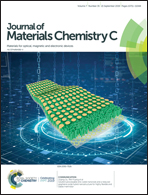Morphology evolution of Eu3+-activated NaTbF4 nanorods: a highly-efficient near-ultraviolet light-triggered red-emitting platform towards application in white light-emitting diodes†
Abstract
A series of NaTbF4 and Eu3+-activated NaTbF4 nanorods with high luminescent efficiency were designed by using an ingenious reaction technique at room temperature. The effect of the synthesis time on the morphology evolution of NaTbF4 nanorods was investigated. Moreover, the influences of the Eu3+ doping concentration on the crystal structure, morphology, electronic structure and photoluminescence properties of NaTbF4 nanorods were systematically studied. Near-ultraviolet (NUV) light was the proper excitation light source for the final products and the optimum Eu3+ doping concentration was 30 mol%. The critical distance of Eu3+ ions in the NaTbF4 host lattices was 11.42 Å and the concentration quenching mechanism was dominated by electric dipole–dipole interactions. The local symmetry properties of Eu3+ ions in the NaTbF4 host were explored by analyzing the optical transition parameters based on the Judd–Ofelt theory. The resultant nanorods not only exhibited splendid thermal stability but also had a high internal quantum efficiency of 50.2%. Additionally, the fabricated light-emitting diode (LED) device can emit glaring white light emission with admirable color properties (i.e., good color coordinates, high color rendering and low correlated color temperature) which slightly changed at high injection current. These achievements suggested that the Eu3+-activated NaTbF4 nanorods were promising red-emitting candidates for high-powered NUV-pumped white-LEDs.



 Please wait while we load your content...
Please wait while we load your content...